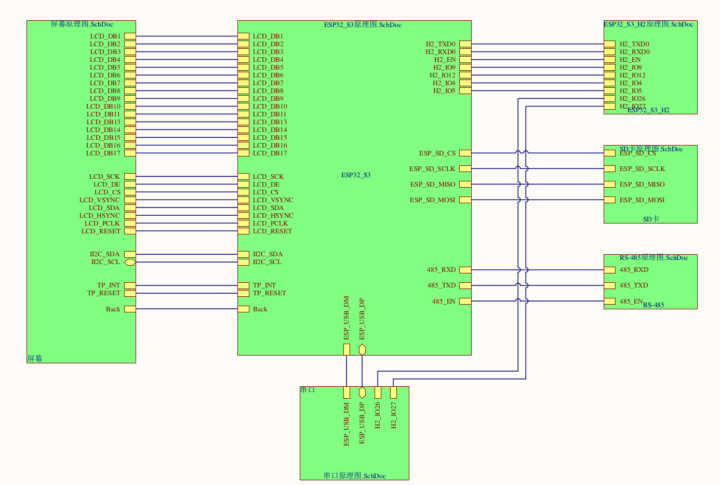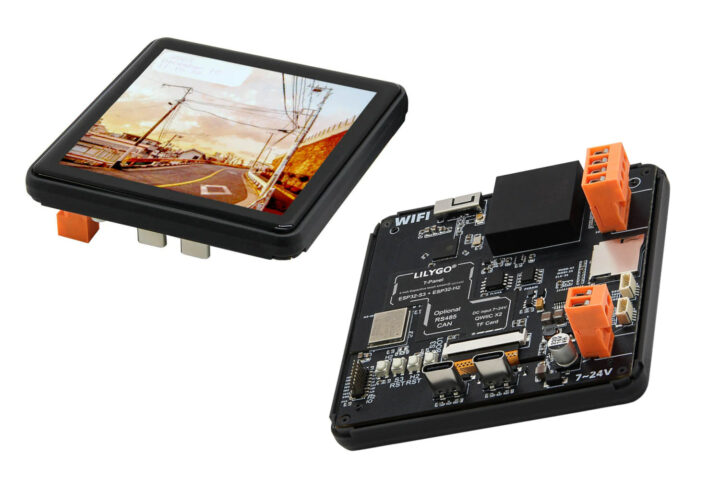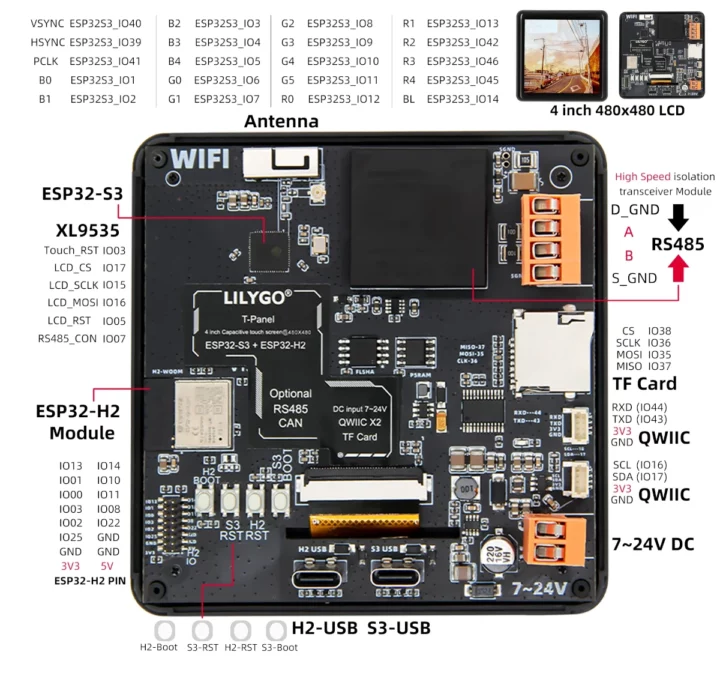LILYGO T-Panel is both a 4-inch HMI display and IoT gateway based on ESP32-S3 WiFi 4 and Bluetooth LE 5 microcontroller and an ESP32-H2 module with Bluetooth LE 5 and an 802.15.4 radio for Zigbee, Thread, and Matter connectivity.
Last year, Espressif introduced the ESP-Thread Board Router/Zigbee gateway board with ESP32-S3 and ESP32-H2 to show how both chips could be combined to create IoT gateways. But I don’t think I had seen a company design a product based on both ESP32-S3 and ESP32-H2 until I saw the T-Panel which also includes an RS485 interface and Qwiic expansion connectors for good measure.
T-Panel specifications:
- Wireless chips/modules
- Wireless SoC – ESP32-S3R8 dual-core Tensilica LX7 microcontroller @ 240 MHz
- 2.4 GHz 802.11n WiFi 4 and Bluetooth 5.0 LE connectivity
- Memory – 8MB PSRAM
- Wireless module – ESP32-H2-MINI-1 module
- MCU – Espressif Systems ESP32-H2 32-bit RISC-V microcontroller at up to 96 MHz with 320 KB SRAM, 128 KB ROM, 4 KB LP memory, Bluetooth 5.2 LE/Mesh and 802.15.4 (Zigbee/Thread/Matter) radios.
- Storage – 4MB flash storage
- PCB antenna
- Dimensions – 13.2 x 16.6 x 2.4 mm
- Wireless SoC – ESP32-S3R8 dual-core Tensilica LX7 microcontroller @ 240 MHz
- Storage
- Storage – 16MB SPI flash (W25Q128) attached to ESP32-S3 MCU
- MicroSD card slot
- Display – 4-inch IPS LCD with 480×480 resolution using ST7701S SPI+RGB controller; The display also seems to support touch through I2C when we look at the T-Panel schematics (and silkscreen on the PCB), but it’s not a feature highlighted by the company…
- USB – 2x USB Type-C ports (one for ESP32-S3, the other for ESP32-H2) for programming
- Serial – 4-pin terminal block connected to RS485 / CAN Bus transceiver module (optional)
- Expansion
- 2x Qwiic connectors (I2C and UART)
- 16-pin GPIO header for ESP32-H2
- XL9535 GPIO expansion chip for extra IO on ESP32-S3 and ESP32-H2
- Misc
- 3D antenna for ESP32-S3 WiSoC
- 4x buttons: Boot and Reset connected to ESP32-S3; Boot and Reset connected to ESP32-H2
- Power Supply – 7V to 24V via 2-pin terminal block
- Dimensions – 89 x 89 x 28.5mm

The specifications mention “Arduino, PlatformIO-IDE, and Micropython” are supported, but that’s just a copy/paste, the actual GitHub repository only provides basic instructions for PlatformIO and the Arduino IDE and further explains that the “ESP32-H2 can only be programmed using the Arduino IDE”.
Available resources include firmware files for ESP32-S3 and ESP32-H2, sample code for the key hardware features (display with Arduino_GFX and LVGL, RS485, SD card, WiFi, etc…), and the PDF schematics. Like other LILYGO hardware, the T-Panel is absolutely not a plug-and-play solution and should be viewed as a “bring-your-own firmware solution” either some Arduino code or a firmware based on Espressif’s ESP Thread Border Router SDK for instance.
LILIGO’s T-Panel can be purchased fitted with an RS485 transceiver on Aliexpress for $58.98 including shipping.

Jean-Luc started CNX Software in 2010 as a part-time endeavor, before quitting his job as a software engineering manager, and starting to write daily news, and reviews full time later in 2011.
Support CNX Software! Donate via cryptocurrencies, become a Patron on Patreon, or purchase goods on Amazon or Aliexpress







What is the intended application for this ?
It is too weak to run a Home Assistant Lovelace UI so cannot be a control panel we would need a raspberry pi for that at the minimum.
As a network proxy / gateway, this would be fine (if it can operate all radio protocols at the same time but this has never been the case so far). Also, the display is superfluous for this role.
Maybe a super simple, hand-crafted room control panel with flexible radio choices (one at a time) ?
For that, it is a bit expensive.
I don’t know Lovelance, but a dual-core Tensilica LX7 should me more then capably of running a nice UI for home automation.
Somebody might be able to develop something similar to the SONOFF NSPanel also based on the ESP32 but lacking gateway functionality:
https://www.cnx-software.com/2021/10/12/sonoff-nspanel-3-5-inch-hmi-display-home-automation/
Maybe as a hoping gateway to many IoT devices
The CPU model number should be something like ESP32-S3-WROOM-1-N16R8. This hardware is probably targeted at this example code: https://github.com/espressif/esp-matter/tree/main/examples/controller
There are two CPU chips because you need two radios to listen for transmissions on two different frequencies (wifi and thread). The radios on ESP32 chips are shared, so if you have wifi and BLE active each is only get half a radio which means they are only listening half of the time. With two radios you can listen all of the time.
These ESP32 chips that support Zigbee and Matter will take off when Arduino libraries are created making it easy to develop Zigbee and Matter applications for use in home automation. I currently use ESP32-S3’s over Wifi/MQTT to create devices for Home Assistant that are simple to develop, and very reliable but use a lot of power.
I also use Wifi/MQTT but have recently tested Thread with a esp32 border router and some esp32c6 clients, but it is not there yet, quite a hassle to get setup and thread connection does not seem to be reliable.
You don’t need to build a border router if you don’t want too. All of the Google, Apple, Amazon devices are border routers now.
I know, but i definitely don’t want to just give those companies an open door to my (thread)network.